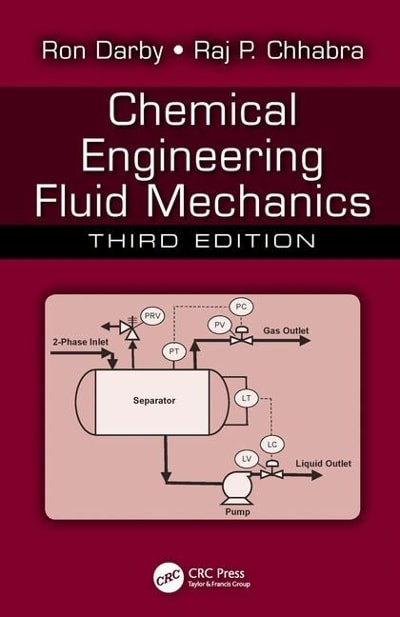Ground coal is slurried with water in a pit, and the slurry is pumped out of the
Question:
Ground coal is slurried with water in a pit, and the slurry is pumped out of the pit at a rate of $500 \mathrm{gpm}$ with a centrifugal pump and into a classifier. The classifier inlet is $50 \mathrm{ft}$ above the slurry level in the pit. The piping system consists of an equivalent length of $350 \mathrm{ft}$ of 5 in. sch 40 pipe and discharges into the classifier at 2 psig. The slurry may be assumed to be a Newtonian fluid, with a viscosity of $30 \mathrm{cP}$, a density of $75 \mathrm{lb}_{\mathrm{m}} / \mathrm{ft}^{3}$, and a vapor pressure of $30 \mathrm{mmHg}$. The solid coal has a $S G=1.5$.
(a) How much power would be required to pump the slurry?
(b) Using the pump characteristic charts in Appendix H, select the best one of these for this job. Specify the pump size, motor speed (rpm), and impeller diameter that you would use. Also determine the pump efficiency and NPSH requirement.
(c) What is the maximum height above the level of the slurry in the pit that the pump could be located without cavitating?
(d) A venturi meter is located in a vertical section of the line to monitor the slurry flow rate. The meter has a $4 \mathrm{in}$. diameter throat, and the pressure taps are $1 \mathrm{ft}$ apart. If a DP cell (transducer) is used to measure the pressure difference between the taps, what would it read (in inches of water)?
(e) A $90^{\circ}$ flanged elbow is located in the line at a point where the pressure (upstream of the elbow) is 10 psig. What are the forces transmitted to the pipe by the elbow from the fluid inside the elbow (neglect the weight of the fluid)?
(f) The classifier consists of three collection tanks in series that are full of water. The slurry enters at the top on the side of the first tank and leaves at the top on the opposite side, which is $5 \mathrm{ft}$ from the entrance. The solids settle into the tank as the slurry flows into it and then overflows into the next tank. The space through which the slurry flows above the tank is $2 \mathrm{ft}$ wide and $3 \mathrm{ft}$ high. All particles for which the settling time in the space above the collection tank is less than the residence time of the fluid flowing in the space over the collection tank will be trapped in that tank. Determine the diameter of the largest particle that will not settle into each of the three collection tanks. Assume that the particles are equivalent spheres and that they fall at their terminal velocity.
(g) The suspension leaving the classifier is transferred to a rotary drum filter to remove the remaining solids. The drum operates at a constant pressure difference of $5 \mathrm{psi}$ and rotates at a rate of $2 \mathrm{rpm}$ with $20 %$ of the surface submerged. Lab tests on a sample of the suspension through the same filter medium were conducted at a constant flow rate of $1 \mathrm{gpm}$ through $0.25 \mathrm{ft}^{2}$ of the medium. It was found that the pressure drop increased to $2.5 \mathrm{psi}$ after $10 \mathrm{~min}$, and the resistance of the medium was negligible. How much filter area would be required to filter the liquid?
Step by Step Answer:

Chemical Engineering Fluid Mechanics
ISBN: 9781498724432
3rd Edition
Authors: Ron Darby, Raj P Chhabra





